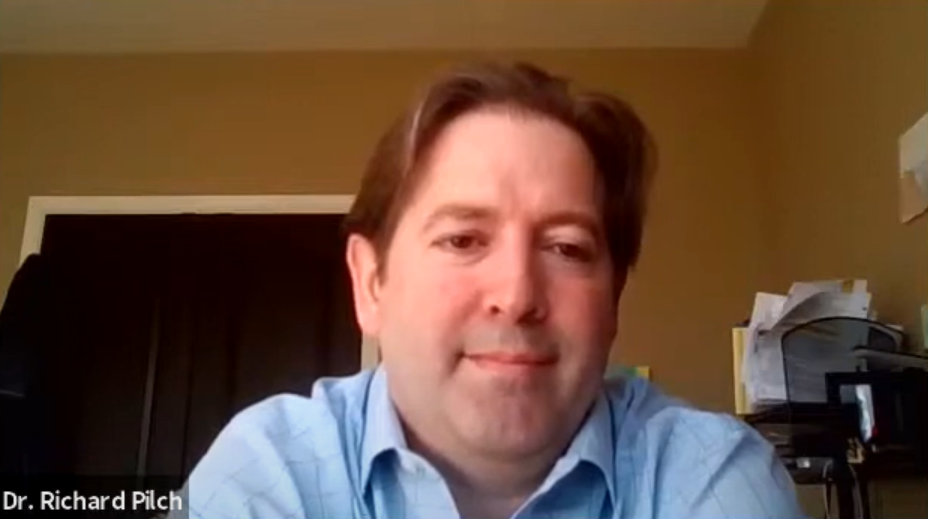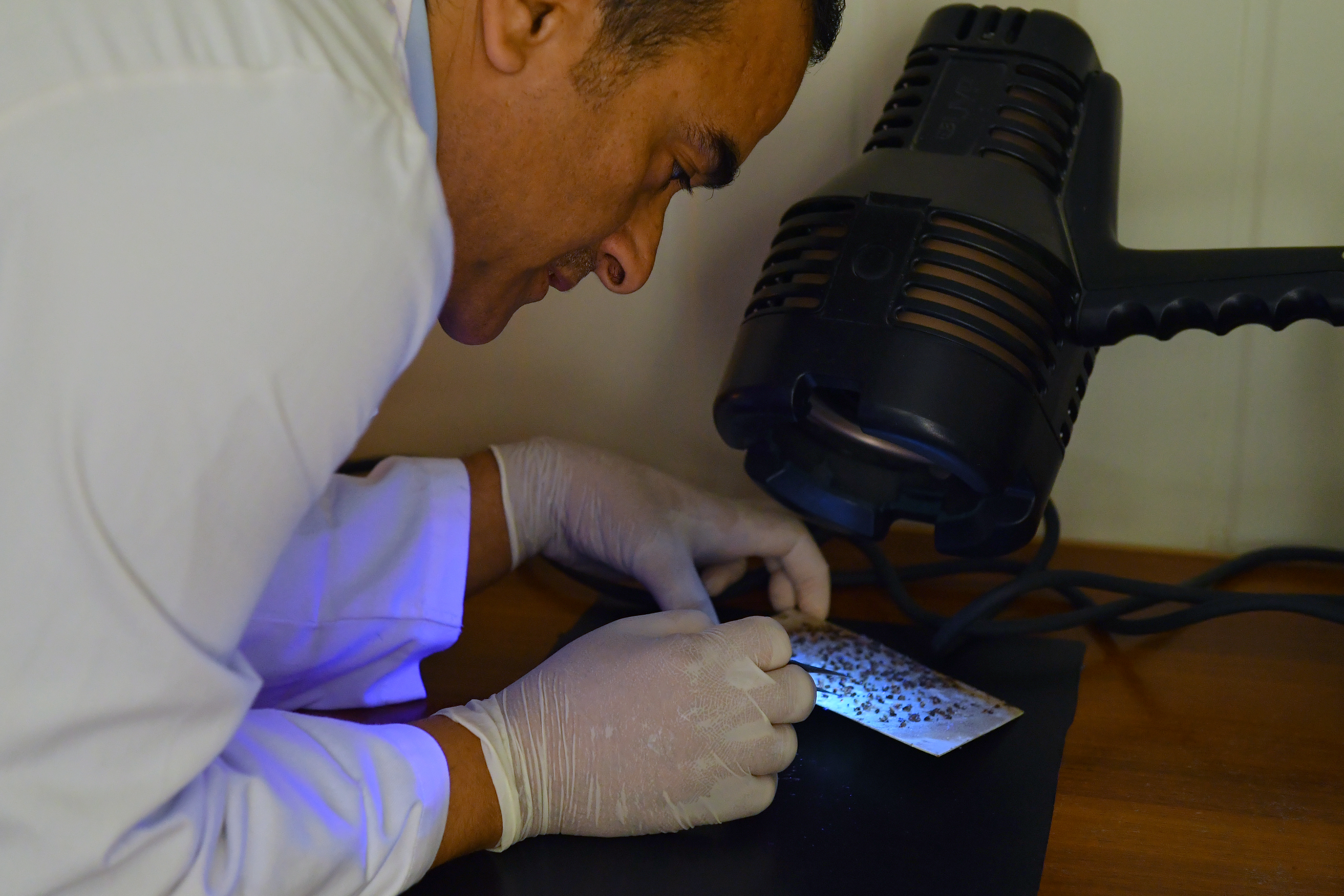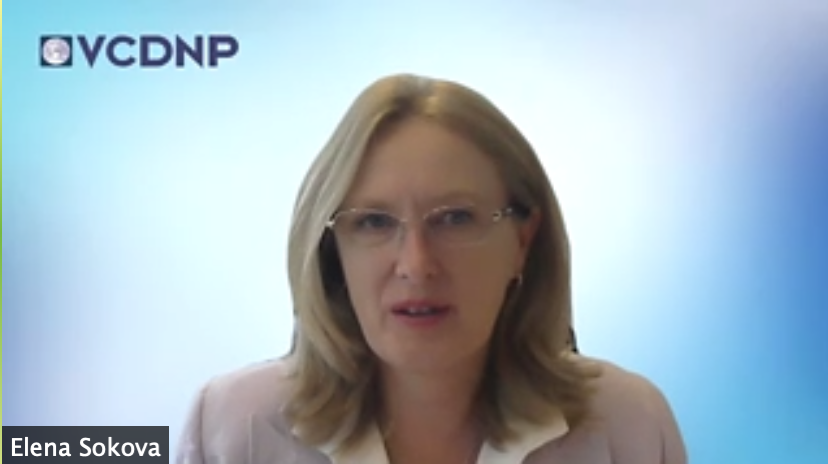
With the COVID-19 pandemic now approaching its first anniversary, there are still many grey areas related to the virus, including its origin, emerging genetic variants and security implications. Dr. Richard Pilch, Director of the Chemical and Biological Weapons Nonproliferation Program at the James Martin Center for Nonproliferation Studies, presented a comprehensive analysis of these issues and offered his recommendations during a webinar entitled “Global Health Security Implications of COVID‑19,” held by the VCDNP on 25 February 2021.
Dr. Pilch listed the following four factors that will shape the further flow of the COVID-19 pandemic: (1) non-pharmaceutical interventions, such as wearing masks, distancing, and limiting indoor gatherings; (2) testing, treatment, contact tracing and quarantine; (3) duration of post‑infection immunity; and (4) vaccination. While the currently authorised vaccines are different in type and have various levels of efficacy, all of them have good safety profiles.
Despite the recent World Health Organization (WHO) mission to China, it is still unknown where exactly the virus started. For Dr. Pilch, however, attribution was less important than answering the key question of when and where the virus adapted for highly efficient person‑to-person transmission. Answering this question can help better understand the risk of virus reintroduction from an unidentified reservoir and of similar viruses emerging among humans.
The pandemic also showed the potential of the virus to cause economic and social disruption, especially given a number of vulnerabilities, such as healthcare capacity limitations and fractured leadership, to name a few. From the viewpoint of biosecurity and terrorism prevention, the pandemic situation has increased the attractiveness to use viruses and other contagious agents for malicious purposes, particularly as this kind of weapon provides asymmetrical advantages of low-cost and low-tech production, and uses humans as “delivery vehicles”.
Dr. Pilch indicated other security implications of the pandemic. One of them is the increased likelihood of humans being in contact with novel disease agents and their animal reservoirs, which could be the result of population growth and industrial expansion. Difficulty of distinguishing between natural, accidental or deliberate outbreaks can lead to their misinterpretation or exploitation in the future. The risk of misattribution is even more serious in countries with nuclear weapons, in which some may use them in retaliation to a presumed biowarfare attack.
As regards possible measures for preventing future pandemics, Dr. Pilch provided two recommendations. First, both supply and demand of disruptive ecological practices should be addressed, including reliance on wet markets and bush meat. Second, an international body and mechanisms should be established to fill gaps in laboratory science, safety and security (S3) – akin the International Atomic Energy Agency and it 3S approach (safety, security and safeguards) to nuclear energy. The S3 mechanisms could include:
In terms of protective measures against future pandemics, the expert suggested establishing a global centralised Crisis Management Authority and developing a comprehensive Global Response Plan that clearly defines roles and responsibilities to ensure initial surge capability to produce equipment and supplies with a possibility to ramp up additional production, and securing scalable healthcare infrastructure.
One of the questions from the public referred to misinformation about the pandemic. The expert mentioned in this regard the WHO Infodemic group and a recent study of the UN Interregional Crime and Justice Research Institute, and set out three essential steps to be taken not only by state bodies but also information platforms: (1) detecting the misinformation and its origin; (2) holding the perpetrators accountable; and (3) countering this information. Long-term resilience to false information can only be built through teaching people to make educated decisions, think critically and cross-reference sources.
Given a considerable number of questions received from the public, Dr. Pilch kindly agreed to answer those he could not address during the event in writing.
(1) What is the importance of biobanking during and after the COVID-19 pandemic?
Biobanking – i.e., the systematic collection of human samples for research – applies in two ways. First, retrospectively, it will enable us to go back and better understand and correlate varying outcomes of COVID-19 in different patients and subpopulations. Second, in the planning forward context, it will enable us to better understand the varying safety and efficacy profiles of different medical countermeasures in different subpopulations, which will help us better manage cases of COVID-19 and similar diseases in the future.
(2) Can climate change have effect on health implications of COVID-19?
It could have an effect on implications of numerous infectious diseases in the future. Climate change directly impacts the “epidemiological triangle,” which is the balance between (1) animal reservoirs where biological agents that could harm us reside, (2) humans, and (3) the environment. The overarching effect of climate change on this triangle is an increasing likelihood that animal reservoirs and humans will come into contact. This can happen in a number of ways – e.g., droughts could create natural predator die-off, such that animal reservoirs expand into human populations; increased rain could cause overgrowth of foodstuffs that animal reservoirs consume, resulting in expansion into human populations; and warming winters could decrease annual insect die-off, increasing vector transmission of disease agents. These are not theoretical concepts – there are examples of natural outbreaks caused by each, for example hantavirus in the US in the early 1990s, which was brought on by drought followed by heavy rains, pine nut overgrowth, reservoir population explosion, and contact with humans. There are also more complex considerations with respect to climate change: for example, an increase in average temperate selects for microorganisms that are thermotolerant, i.e., better able to survive at higher temperatures. That same selection helps microorganisms survive better in animals and humans, where our body temperatures might otherwise provide a protective effect. So we have seen an example already where climate change has led to selection of a thermotolerant fungus, Candida auris, which then was able survive in animal carriers and ultimately reached and caused illness in humans.
(3) Has the origin country of outbreaks or pandemics ever been held accountable and obliged to provide compensation to other states affected?
There are no known cases of that. In the case of COVID-19 or other pandemics, it is first and foremost extremely challenging to demonstrate accountability. At the international level, a useful comparison might be World War II, after which Germany did provide reparations to other nations; in that case, however, Germany’s accountability was not in question. If a nation (or individual) were to try to pursue reparations in their national court systems instead, there are also a number of limitations that make success unlikely, including foreign immunity statutes (in the US, this is covered under the Foreign Sovereignty Immunities Act). Regarding past pandemics specifically, the only precedent Dr Pilch is aware of is after the 2009 H1N1 influenza pandemic, which began in Mexico and spread from there around the world. Surprisingly, it was Mexico that sought reparations from the international community, citing its transparency during the early stages of the outbreak as substantially benefiting other nations while its own tourist industry suffered the consequences. It would be interesting if, in the case of COVID-19, China responded to lawsuits with their own lawsuits in this same vein, citing its early sharing of the SARS-CoV-2 (COVID-19) sequence as substantially benefitting other nations to its own detriment.
(4) How can countries, which work on establishing biosecurity legal frameworks, accelerate the process?
Dr. Pilch recommends consulting with the Global Partnership Against the Spread of Weapons and Materials of Mass Destruction or cognizant UN bodies, which actively work to assist nations in this capacity. He would be happy to assist personally as well.
You may also wish to read A Guide to Investigating Outbreak Origins: Nature versus the Laboratory, co-authored by Dr. Pilch.
The recording of the webinar is available below.

